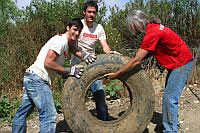
|
 |
 |
 Editorials | Environmental | June 2008 Editorials | Environmental | June 2008  
US/MEX: Neighbours Try to Reclaim Polluted Valley
 Enrique Gili - Inter Press Service Enrique Gili - Inter Press Service
go to original


| | Volunteers Aritz Aduriz and Igor Gabilondo dispose of an old tire. (Alfonso Lopez) | | |
San Diego, California - A sinuous coil of murky water winds through the Tijuana River Valley. On each side of the U.S.-Mexican border, residents eye each other warily, caught in the cross-currents of political intrigue and economic polices that make the floodplain seem almost orderly by comparison.

Wedged between the ocean, the border and the southern fringes of suburban San Diego, California, the valley is contested territory. Horse ranchers and bird fanciers make their home here, but the valley also serves as a flashpoint for migrants desperately seeking entry into the United States. A patchwork of state, local and federal agencies with competing interests makes collaboration difficult. Enforcement, conservation, and recreation all vie for top priority.

However, there's one aspect of border life everyone can agree upon. The region is inundated with trash, the waste of two large cities, illegal dumping and maquiladoras, and is the victim of neglect. Much of the 2,700-square-kilometre watershed is located in Mexico but the terminus is an estuary and Imperial Beach, San Diego, the last and southernmost beach town in California.

At the urging of Benjamin McCue, programme manager for WildCoast, a bi-national wildlife conservation and water quality advocacy group focused on Baja, California, 200 volunteers armed with plastics bags, rakes and shovels recently attempted the seemingly impossible - to clean-up a tiny sliver of the valley set aside as a nature preserve, known as the Tijuana River Open Space Reserve.

"Cross-border pollution is the number one border threat," said McCue. "The threat is not what comes over the fence, it's what comes under it. Pollution affects the health of everyone."

Pollution doesn't respect the border. Each time it rains, a portion of Tijuana's waste flows through the estuary and into the Pacific Ocean, shutting down local beaches for days at a time and affecting the quality of life for residents. Local residents are seeking common ground to combat the problem.

"To comprehensively deal with the Tijuana River, we need to involve everyone impacted from ranchers to surfers to border patrol agents," said Paloma Aguirre, president of the Tijuana River Citizens Council.

Postcard pretty wetlands hide hidden trash. Beneath beds of wildflowers and lush vegetation, the preserve is a catchall for all manner of debris, tires, bottles, and plastic. By mid-morning, volunteers have accumulated enough garbage to fill a shipping container to haul to the municipal dump.

Even as clean-up efforts get underway, certain border realities are difficult to ignore or downplay. Border patrol agents are actively pursuing migrants hiding in the vegetation, leading more than one volunteer to quip it's doubtful "illegals" are slipping across the border to pick up trash.

The magnitude and scope of the pollution problem largely depends on whom you ask.

"I think the perception of industrial pollution is higher than it actually is, not to say there isn't a problem," said Dr. Richard Gersberg, a public health professor at San Diego State University. "It's not like we have major, heavy industry."

Discussions on the root causes of pollution in the valley often lead to debates over who benefits from free trade on the border. Maquiladoras - factories that make goods exclusively for export - form the backbone of Tijuana's economy. Trade agreements like NAFTA have made the city an ideal location for multinational corporations to set up shop, although labour activists have long complained that the conditions at many plants are exploitive and even abusive.

Lured by the promise of jobs, an estimated 50,000 new arrivals settle here each year. Unincorporated colonias then arise to accommodate the influx of people. With nearly 1.5 million people living in the vicinity and a growth rate of 4.5 percent, Tijuana's infrastructure is overburdened. Hundreds of thousands of people in the city are not hooked up to the municipal sewage system, forcing the city to play catch-up.

Twenty-five million gallons of Tijuana's sewage is processed each day, an impressive number except for the fact that only 36 percent of the city has adequate sanitation.

However, the city has made significant strides in meeting the needs of previously underserved communities. Since 2001, 200,000 households have been added to the public utility system. But with hundreds of thousands more residents living off the grid, raw untreated sewage presents an ongoing problem.

It's the kind of scenario San Diego city councilman Ben Hueso finds daunting. "If you think of thousands of homes that aren't plugged into the sewage system, you can imagine them collectively flushing their toilets at the same time [and] what that would cause in terms of run-off," he said.

Much of the overflow winds up in his district, significantly impacting the economy of San Diego's Southbay region. Plumes of raw sewage entering the Pacific Ocean mean beach closures for seaside towns that rely on tourism.

Hueso also acknowledges an unwillingness - some might say an intransigence - on the part of U.S. authorities towards their neighbours. "No one wants to talk about investing money in Mexico when there are so many unmet needs here. That's a political hot potato," he said.

But if you ask the volunteers of WildCoast, they might say that sometimes, doing the right thing means leading by example even if the outcome is far from certain. | 
 | |
 |



